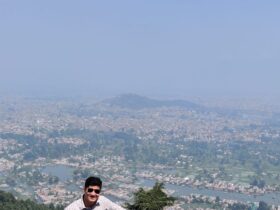Yasmeen
Tireless rains tore through Kashmir-known to the world as the paradise in September 2014. It rained, rained and rained, glaciers were swept away and Kashmir, it seemed was heading towards its worst floods.
JHELUM-the pride of Kashmir was swollen beyond its capacity. Its boundaries were shaking ,its embankments were leaking.It assumed power in no time and roared into parts of Anantnag first.
While the world slept peacefully on the night of September the 6, whole Kashmir was restless. Jhelum was roaring. Would it find a shelter in our homes the dwellers of Srinagar city thought.
Early morning of September 7th, Jhelum grew in its might. The barriers of the city were knocked down. The waters of Jhelum were on a destruction spree. Jhelum spinned and swallowed everything that came its way.
Innocent River of life had become a river of death.
And,
All that was visible became invisible.
All that was apparent became unapparent,
All that was erect was submerged,
All that could be swept was swept away in a wrath.
Who had seen Jhelum in such a mood?
Who had predicted that the river would bring such a trauma, such destruction?
The commercial hubs were destroyed
LalChowk became a brown chowk, it became a chowk of lost dreams, a chowk of lost hope.
A small time trader lost his life’s earnings
A successful businessman building empires saw his hope being immersed in dirty waters.
A shopkeeper lost his shop.
A hotel owner lost his hotel.
1 trillion crore was the estimated loss
A loss that would take decades to be compensated.
Posh dwellings seemed soaked and bathed as if in ash!
Rajbagh lost all its palaces
Historical, monumental, archival and ornamental.
Those educational hubs of the yore became swamps and marshes
Collapsing schools with smashed furniture gave us our “dreads of tomorrow”
Floating books and immersed bags snatched away dreams of our children.
Healthcare was blown apart….functionless
Hospitals struggled amidst deadening waters
Kids died, pregnant women couldn’t be saved and life became a causualty
Thousands of animals died-helpless before the fury of the nature.
Struck by grief, homelessness, and uncertainty-A Kashmir rose to fight the fury.
He helped his brother though was himself in need of help.
He dived into the fierce waters to pull out his brother.
He dived into the dirty pools to help his brother quench his thirst.
He dived into the unknown just to save his neighbor’s cat.
He died poor guy-but died a great human, saving lives and helping the needy.
Post floods too-he didn’t stop….
He went on a mission of self-help, a mission of salvaging, a mission of reconstructing
He just didn’t brood over his loss, didn’t cry over it but went on doing what he could
Maintaining his grace and self respect.
But the loss is massive…
Who will build it all?
Who will refurbish?
Who will reconstruct?
Who will rehabilitate?
With tough winters, on-it is cold out there in the tents
It is hard living without a livelihood.
It is hard feeding a family with no means.
It is hard arranging again for a daughters marriage.
It is hard paying for son’s education.
God has given us enough to help these brave men in need.
Flora and Fauna of Kashmir sufferd a great loss which would take years to get back into the original form.Kashmir suffered loss in terms of vegetation, wetlands & much more.Kashmir floods were a grim reminder that climate change is hitting India harder.
As for Kashmir, weatherman blamed the interaction of the western disturbances with the monsoon current for causing frequent rains but environmentalists wondered why the government is still silent on the issue of climate change.
Rising temperatures have not only resulted in greater glacial melt but are also weakening monsoon circulation, resulting in greater precipitation. Climate change impacts on monsoon behavior and glacial systems result in great flooding risks.Therefore it turns out that the Kashmir valley is extremely vulnerable to climate change and particularly vulnerable to increased flooding.
The wetlands of the Kashmir Himalaya have been made inhospitable by recurring flooding. As a result of heavy deposits of silt, manyimportant species of plants and animals have vanished and many more are losing their habitats: in contrast, however, a few new species are appearing and spreading fast. The destruction caused by flood waters and sediment deposition is detrimental to many species of water-birds inhabiting the wetlands. Adequate flood control measures are essential to ensure the survival of these productive ecosystems.
The study – conducted by around 250 scientists from more than 20 institutes like the Indian Institute of Tropical Meteorology, National Institute of Oceanography, IIT and JNU Said, “With increasing temperatures, it is anticipated that there may be an all-round decrease in apple production in the Himalayan region, and the line of production may shift to the higher altitudes,” it said, adding, “Flash floods due to glacial lake outbursts may lead to large-scale landslides and affect food security and hence nutritional health”.
Climate change during last few decades had a significant impact on the high mountain glacial environment. Glaciers are highly sensitive to minor changes in the atmospheric temperature. Therefore, glaciers are considered as very good indicators that help us to quantify changes in the Earth’s climate. It is widely confirmed that climate change is the main factor behind the accelerated glacier retreat observed in the Himalayas. The melting of Shiva Lingam (made with ice naturally) in the holy cave of Amaranth in Jammu and Kashmir is a clear indication of increasing temperature in the Himalayan region . It is forecasted that the Himalayan glaciers could shrink to 100,000 square km (38,610 square miles) by the 2030s, from 500,000 square km (193,100 square miles) now, if the current pace of global warming continues .
Some of the most immediate effects of recent climate change are becoming apparent through affects on biodiversity. The life cycles of many wild and domestic plants and animals are closely linked to the passing of the seasons and climatic changes. The decreasing water budget in these rivers year after year, coupled with the ever increasing incoming sediment load, has ‘choked’ the minor drainages and is continuously silting up, at an alarming rate, even the major river system.
Climate change is a major concern in the Himalayas because of its potential impact on the economy, ecology, and environment of the Himalayas and areas downstream. It is the home of so many glaciers, rivers and distinct flora and fauna. A wide range of distinct variety of habitats supports great world’s genetic resources of both flora and fauna in their unique ecological province. Habitat destruction, land-use/cover change, land degradation, forest fire have adversely affected biological resources of the sub-region induced by climatic change. The various altitudinal zones of the regions are witnessing major biodiversity, ecological and geophysical changes. The increasing unpredictability of weather and the natural catastrophes in the region are clear-cut indicators of marked shift in weather patterns in the region. Various control measures and management steps in the form of afforestation, reforestation, landscape management, tourism management, reducing energy consumption, increasing energy efficiency, promoting renewable energy technologies, control on green house emission, prediction model, regular monitoring and more research on related aspects of climate and biodiversity are needed in order to save the Himalayan region from decline of its wealth present in the forms of natural sources.
Kashmir has been suffering from decades sometimes in the form of unrest, sometimes in the form of earthquakes & now the floods and disturbed ecological balance. Kashmir will take a long time to grow again into the period which it used to be before 80 years.
All has happened in past 50-60 years, but we need to come up with rescue operation immediately. We had already been advised by thePatron Saint of Kashmir,Sheikh Nur-ud-din Wali [RA]about the importance of forests and biodiversity. He [RA] once quoted:’An poshi teli yeli wan poshi’ ‘Food will suffice till forests survive’I think Sheikh Nur-ud-din Wali (RA) was the first environmentalist who predicted the importance of forests at the time when there was no danger of losing biodiversity and forest resources.He (RA) predicted because he was a visionary religious philosopher who hadimagined theimpact of forest on human welfare.Although we have not included environmental aspect in our ethical framework, butinclusion of these issues are our social obligations. There are counter arguments regarding the importance of biodiversity with respect to social and ethical framework. Some people argue that the idea of biological diversity teaches us unity in diversity among living and non-living organisms.

















Leave a Reply